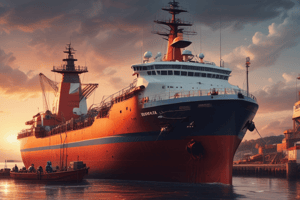Podcast
Questions and Answers
What is the accepted emergency signal for calling crew and passengers to lifeboat muster stations?
What is the accepted emergency signal for calling crew and passengers to lifeboat muster stations?
The accepted emergency signal for calling crew and passengers to lifeboat muster stations is the general emergency alarm.
When must emergency drills be carried out on a ship?
When must emergency drills be carried out on a ship?
Emergency drills must be carried out at least once a week.
List four types of emergency drills that must be conducted on a regular basis.
List four types of emergency drills that must be conducted on a regular basis.
Four types of emergency drills that must be conducted on a regular basis are: lifeboat drills, fire drills, abandon ship drills, and man overboard drills.
What five statutory items must the relieving officer be informed of by the officer in charge of the engineering watch before taking over the engineering watch?
What five statutory items must the relieving officer be informed of by the officer in charge of the engineering watch before taking over the engineering watch?
What is the minimum passing score on this Certificate of Competency Examination?
What is the minimum passing score on this Certificate of Competency Examination?
What type of calculator may be used during this examination?
What type of calculator may be used during this examination?
What must be stated for any formulae used in answering the examination questions?
What must be stated for any formulae used in answering the examination questions?
State the limit on oil discharge.
State the limit on oil discharge.
List FOUR items which must be recorded in the Oil Record Book when bilges are pumped overboard using a non-automatic system.
List FOUR items which must be recorded in the Oil Record Book when bilges are pumped overboard using a non-automatic system.
State what should happen if the content of the oil in the discharge overboard is detected as exceeding the limit set using an automatic system.
State what should happen if the content of the oil in the discharge overboard is detected as exceeding the limit set using an automatic system.
List THREE conditions/faults which interfere with oil water separation.
List THREE conditions/faults which interfere with oil water separation.
State the meaning of the term closed flash point.
State the meaning of the term closed flash point.
State the maximum temperature at which diesel fuel oil can be stored.
State the maximum temperature at which diesel fuel oil can be stored.
Explain why a representative sample of the fuel should be obtained.
Explain why a representative sample of the fuel should be obtained.
State how long a fuel oil sample should be retained on board.
State how long a fuel oil sample should be retained on board.
State TWO tests which should be carried out on a sample of fuel before commencing bunkers.
State TWO tests which should be carried out on a sample of fuel before commencing bunkers.
Describe the term Reverse Osmosis.
Describe the term Reverse Osmosis.
Sketch a Reverse Osmosis system and label all components.
Sketch a Reverse Osmosis system and label all components.
Describe the construction and operation of an Active Controlled Tank roll damping system.
Describe the construction and operation of an Active Controlled Tank roll damping system.
Describe the examination and testing of portable fire extinguishers as specified in the UK and International legislation.
Describe the examination and testing of portable fire extinguishers as specified in the UK and International legislation.
State the classes of fire that Dry powder extinguishers may be safely used for.
State the classes of fire that Dry powder extinguishers may be safely used for.
Describe the operation of a portable CO2 fire extinguisher.
Describe the operation of a portable CO2 fire extinguisher.
Explain the meaning of the term 'beam' in a vessel's structure.
Explain the meaning of the term 'beam' in a vessel's structure.
Define the term 'frame' in the context of a vessel's structure.
Define the term 'frame' in the context of a vessel's structure.
What is the role of a 'girder' in a vessel's structure?
What is the role of a 'girder' in a vessel's structure?
Explain the term 'beam knee' in the context of a vessel's structure.
Explain the term 'beam knee' in the context of a vessel's structure.
Define the term 'stringer' in relation to a vessel's structure.
Define the term 'stringer' in relation to a vessel's structure.
Flashcards are hidden until you start studying
Study Notes
Emergency Signals and Drills
- The accepted emergency signal for evacuating crew and passengers to lifeboat muster stations is a prolonged blast of the ship's whistle or alarm system.
- Emergency drills must be conducted on ships at least once every three months.
- Regularly conducted emergency drills include:
- Fire drills
- Abandon ship drills
- Man overboard drills
- Emergency equipment drills
Engineering Watch Protocol
- Before taking over the engineering watch, the relieving officer must be informed of:
- Status of machinery
- Fuel and lubricating oil levels
- Any maintenance or repairs needed
- Operational parameters and alarms
- Safety concerns or potential hazards
Examination and Scoring
- The minimum passing score on the Certificate of Competency Examination is typically set at 70%.
- Only non-programmable calculators may be used during this examination.
- Any formulae utilized for exam questions must be clearly stated and explained.
Oil Discharge Regulation
- The limit on oil discharge is set at 15 parts per million (ppm).
- When bilges are pumped overboard using a non-automatic system, the Oil Record Book must record:
- Date and time of discharge
- Quantity of oil discharged
- Reason for discharge
- Operational status of the oil water separator
Oil Discharge Compliance
- If the oil content in the discharge overboard exceeds the regulatory limit, discharge must be stopped immediately and recorded.
Oil Water Separation Issues
- Conditions or faults that may interfere with oil water separation include:
- High viscosity of oil
- Temperature fluctuations
- Equipment malfunctions
Fuel Characteristics and Sampling
- Closed flash point refers to the lowest temperature at which vapors can form above a liquid and ignite in the presence of an ignition source.
- Diesel fuel oil can be stored at a maximum temperature of 60°C.
- A representative fuel sample should be obtained to ensure quality and compliance with specifications.
- Fuel oil samples should be retained onboard for a minimum of 12 months.
- Tests to be carried out on a fuel sample before starting bunkering include:
- Viscosity test
- Flash point test
Reverse Osmosis
- Reverse Osmosis is a water purification process that removes contaminants from water by using pressure to force water molecules through a semipermeable membrane.
- Components of a Reverse Osmosis system include:
- Pre-filter
- High-pressure pump
- Reverse osmosis membrane
- Post-filter
Vessel Structure Terminology
- The term 'beam' refers to the width of the vessel at its widest point.
- 'Frame' describes the structural components providing shape and support within the hull of the vessel.
- A 'girder' is a large horizontal beam that helps support the superstructure or deck of the vessel.
- 'Beam knee' is a connection element that supports the intersection of various structural components.
- A 'stringer' refers to elongated structural members that strengthen the hull along its length.
Studying That Suits You
Use AI to generate personalized quizzes and flashcards to suit your learning preferences.




